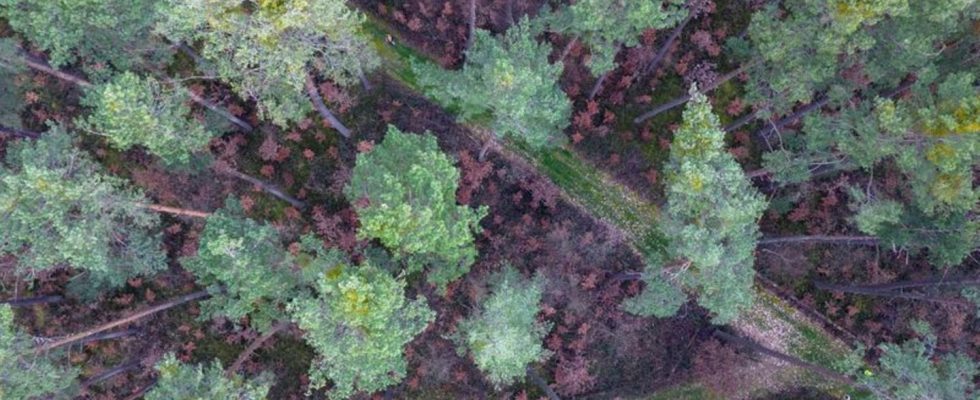Nature
Future of the forests – rebuild, but how?
Many beech trees planted a few years ago stand with brown leaves close to the ground in a pine forest that will die off over the next two decades. photo
© Daniel Löb/dpa
Drought, storms, pests – tons of trees are dying in Germany as a result of global warming. How can forests become fit for the future? Visiting a “forest of the future”.
The pine trees rise many meters high. Young oaks, copper beeches, rowan berries, birches and several other tree species grow underneath. A mixed forest that does not occur naturally around the Bavarian community of Rohr in Middle Franconia. But he could forest owner Ralf Straußberger hopes. “If the pines die, I’ll have the next forest already there.”
According to experts, pine forests, which mainly characterize the area, have no chance of long-term survival due to global warming. That’s why the forester and forest expert from the Federal Nature Conservation Association teamed up with other forest owners in the region to convert a total of 300 hectares into what they call a “forest of the future”. Tree nurseries have planted almost a million seedlings since 2011. “We have the largest forest conversion project in Bavaria in a private forest,” says Straußberger.
Elsewhere in Germany, forest administrations, forest owners, initiatives and scientists are also thinking about how the forest can withstand rising temperatures and increasing temporary drought. The United Nations International Day of Forests highlights the importance of preserving forests every year on March 21st. But what actually defines the forest in Germany? And how can the conversion succeed?
the initial situation
According to the 2012 Federal Forest Inventory, 11.4 million hectares of Germany are forested, which is around a third of the country’s area. The most common tree species are spruce and pine – a legacy of our history: In the Middle Ages up to the 19th century, many forests were cleared and reforested with these fast-growing tree species. However, these monocultures are now proving to be particularly vulnerable to pests, storms and heat. According to the Association of Forest Owners in Germany, almost three million hectares of forest must therefore be converted. The costs are therefore up to 43 billion euros over the next 30 years.
The possible solution and a problem
“We are trying to increase the range of species in order to minimize the risk,” says Erwin Hussendörfer, professor of silviculture at the Weihenstephan-Triesdorf University in Freising, summarizing the general credo. However, there is a problem: “Trees live to be 100 or 200 years old. It becomes difficult to predict how the climate will change by then.” That’s why you can currently only make assumptions, exclude certain tree species such as pine and spruce and favor others. From his point of view, one thing is certain: “Our forests will look different in the future.” And forest conversion is happening far too slowly. “The time is running out.”
Forest often privately owned
Almost half of the forests in Germany are privately owned. “95 percent of forest owners have a forest area smaller than 20 hectares. For many, the forest is a hobby, a family tradition,” says Irene Seling, general manager of the Association of Forest Owners. Some of them live far away from their forest or, for professional reasons, do not find the time to manage it – let alone convert it to suit the climate. Especially since the specialist knowledge for this is often lacking. “It will not be possible to develop a one-size-fits-all solution,” says Seling.
Ralf Straußberger also inherited his 20 hectares of forest from his parents. As an expert, however, he has an advantage: he has been experimenting in the ten forest areas for a long time to find out how best to grow mixed forest. His experience: It is more difficult to implement this on small areas. “It’s more expensive, ineffective and it doesn’t work with hunting either.”
That’s why he joined forces with neighbors in Rohr for the forest project. “This also motivated owners who don’t have much knowledge.” An important component here: Straussberger and other area tenants are increasingly going deer hunting in the project area so that the game does not nibble on the young trees en masse. This means you can get by without expensive fences, he says. “This makes it much more lucrative. With a fence, you pay extra for forest regeneration despite government funding.”
Let it grow or intervene?
But why can’t you just leave the forest to itself? Nature takes care of it itself – you might think. “The forest doesn’t need people. But we need the forest,” says Ulrich Schraml, director of the Baden-Württemberg Forestry Experimental and Research Institute in Freiburg. That’s why it has to be designed in such a way that the next generation can still benefit from it. “Nature can only access what is there,” adds Straussberger. In other words: Beech trees will not grow on their own in pure pine and spruce forests because the mother trees and their fruits are missing.
From Schraml’s point of view, rare species and young trees also have more chances to grow if old trees are deliberately felled. “If there are too many large trees, they take away water and light from the smaller ones.” The rare whitebeam, for example, which does not grow particularly tall but needs a lot of sun, also benefited from this. However, the question arises as to how strongly we should intervene, says silviculture expert Hussendörfer. “In many areas you should observe the natural development for a while and then supplement it meaningfully.”
Federal Statistical Office on logging Forest owners on the crisis in the forest Information on the Rohr forest of the future Information on Forest Day Information Federal forest inventory

